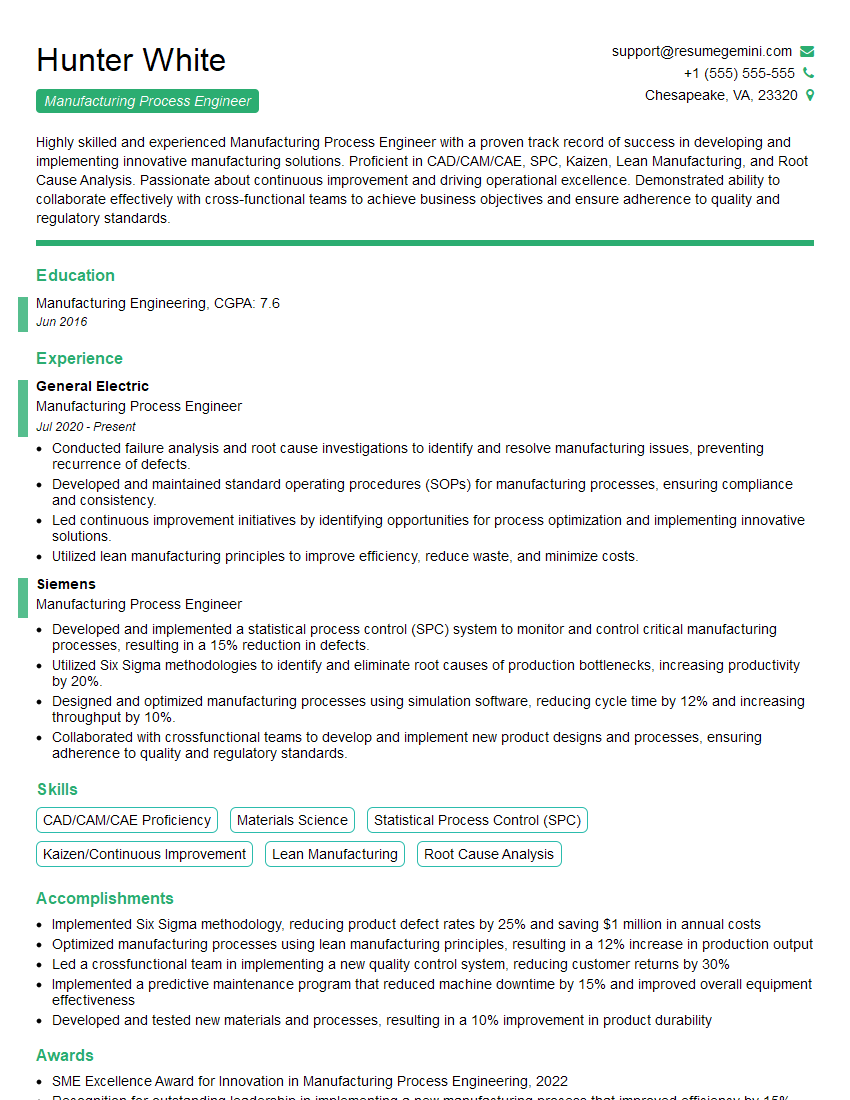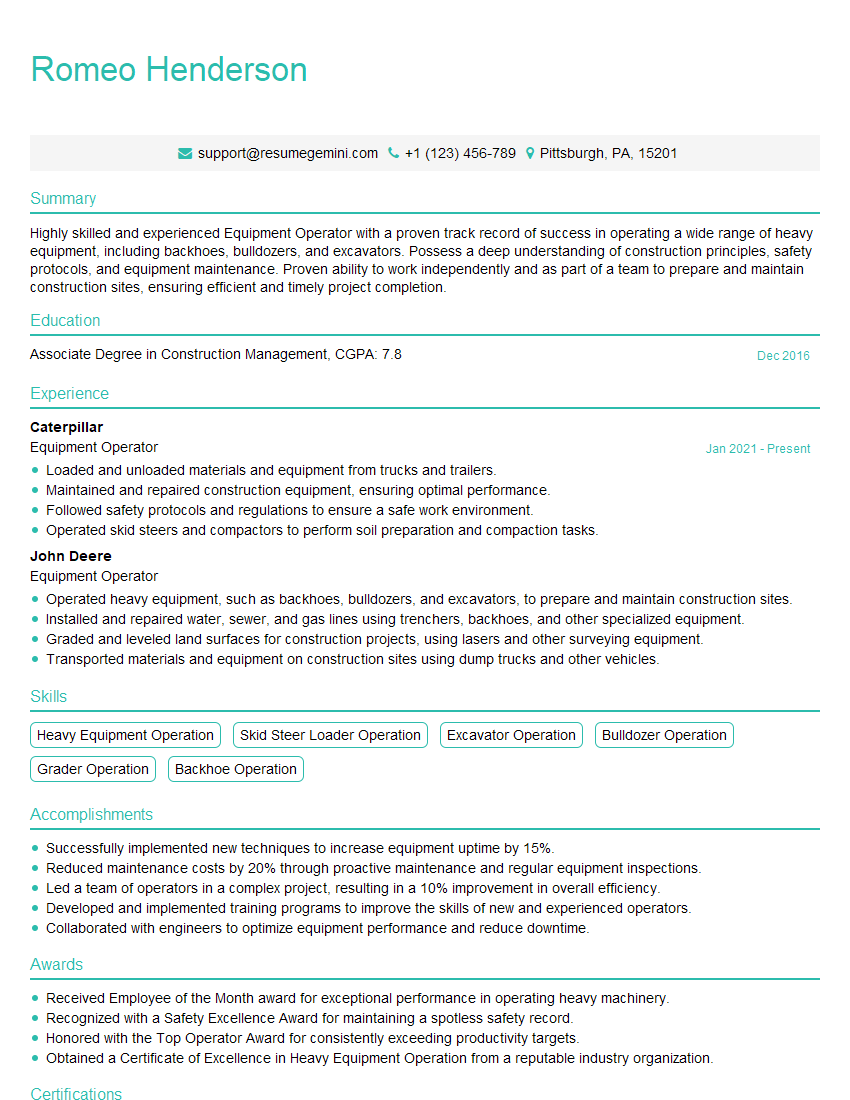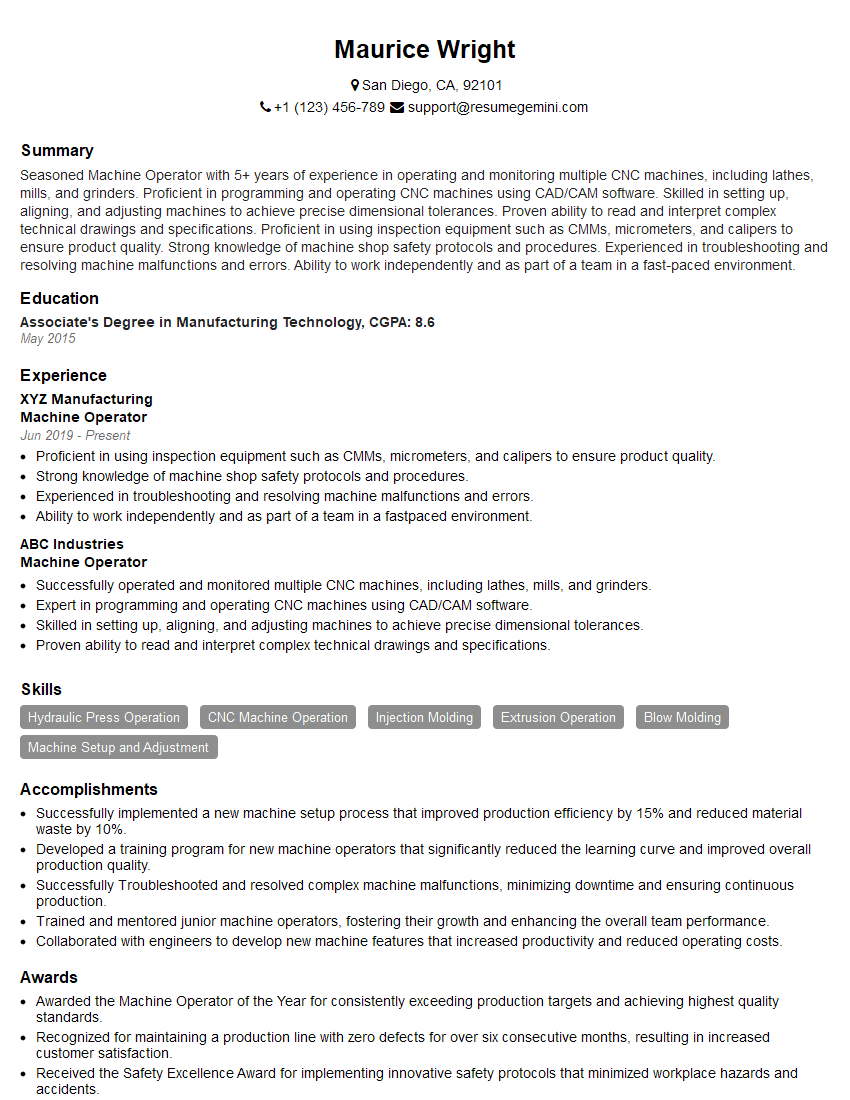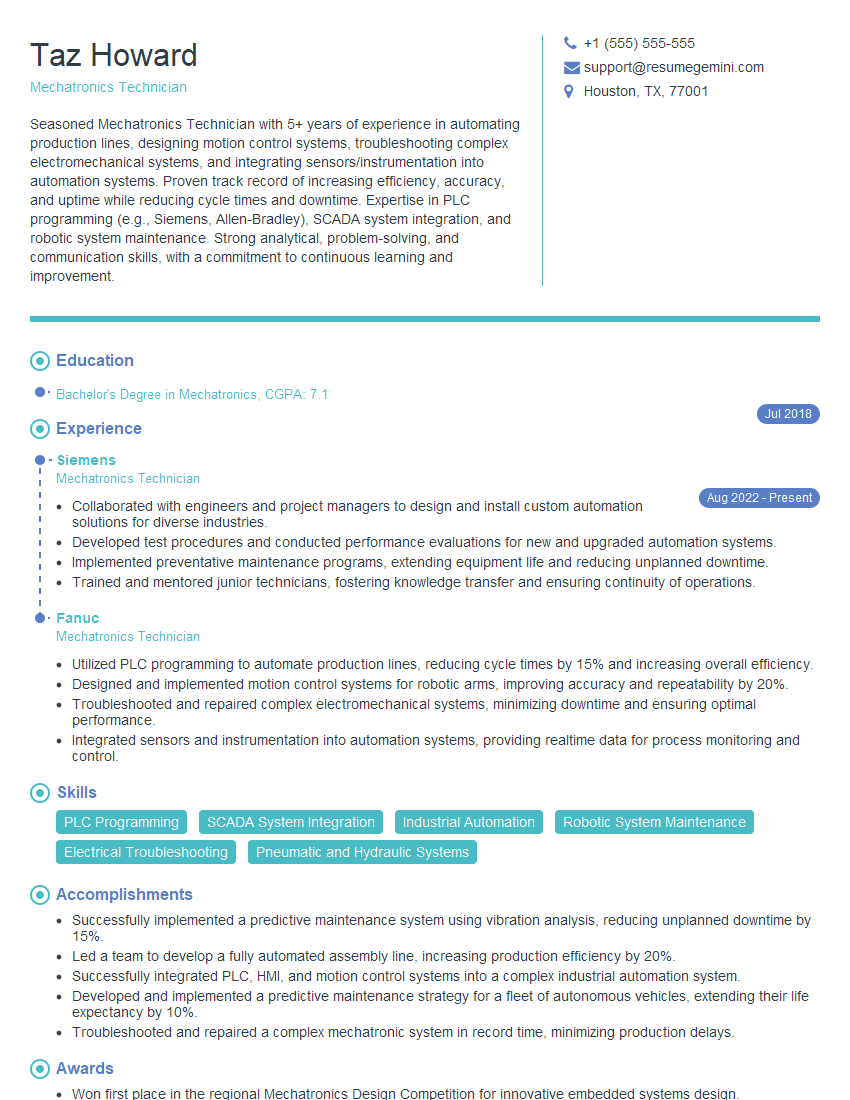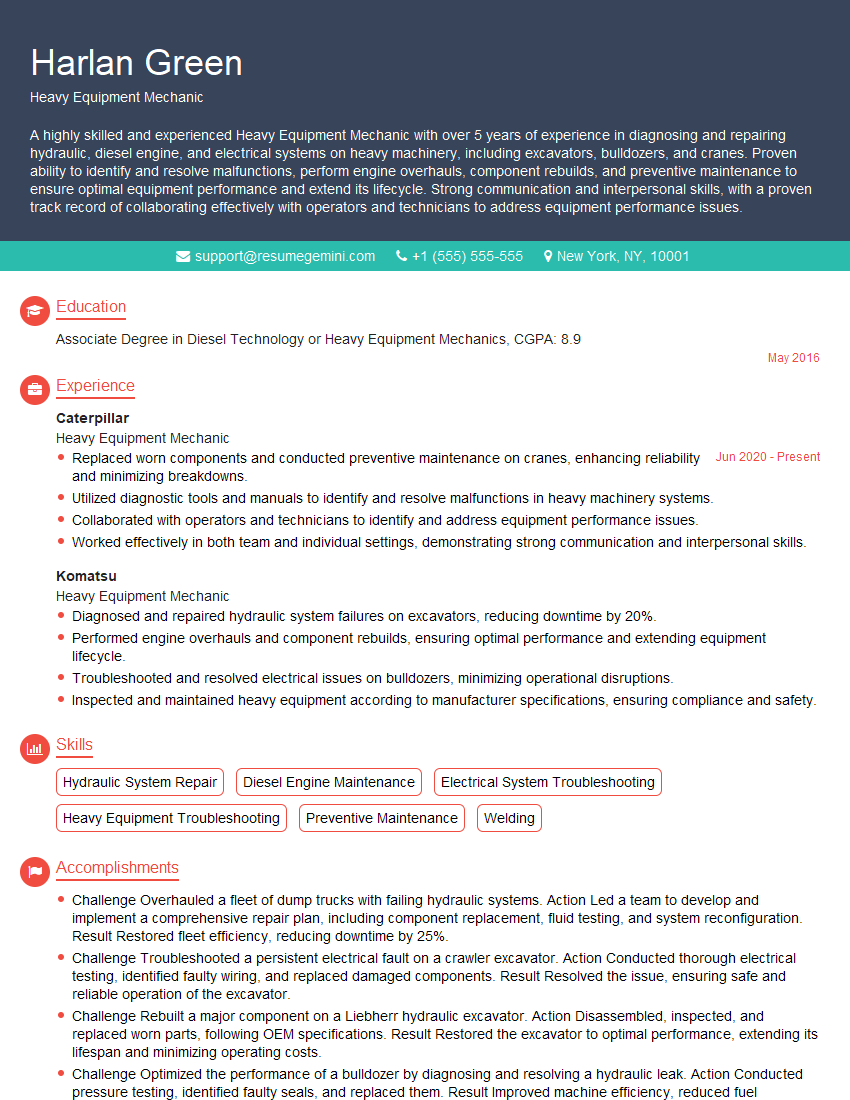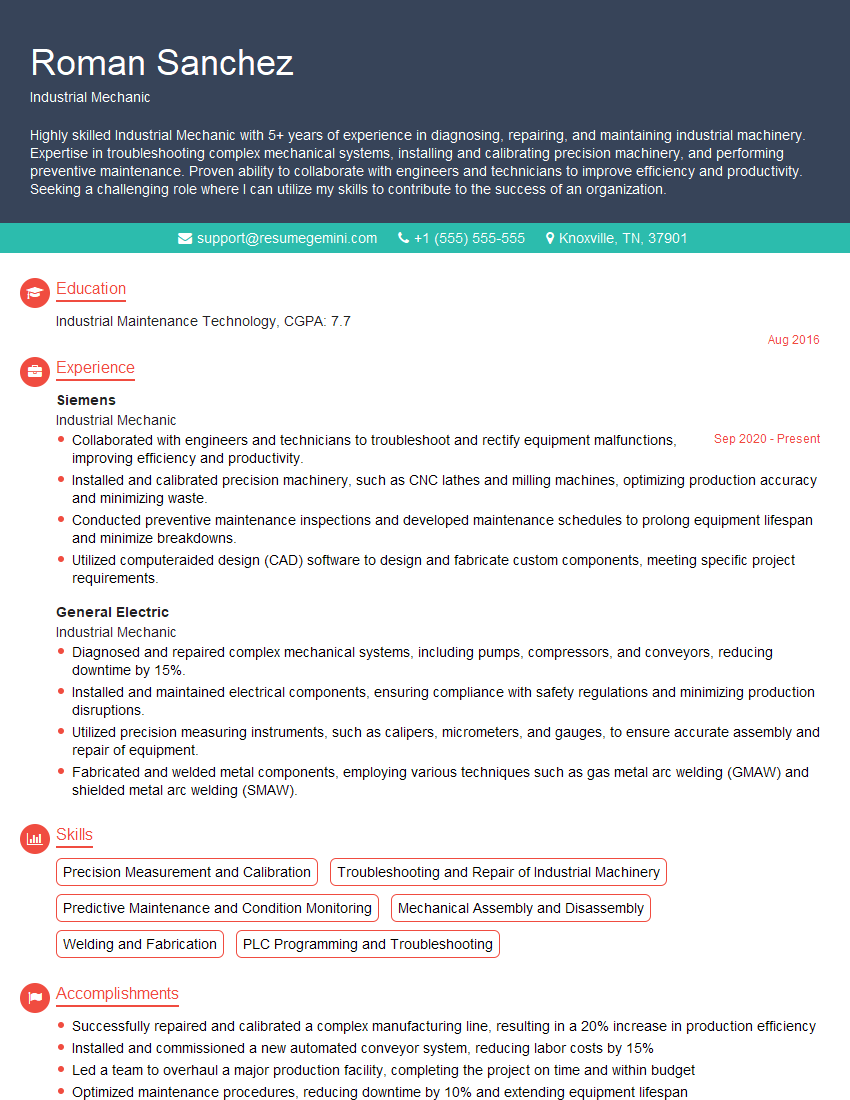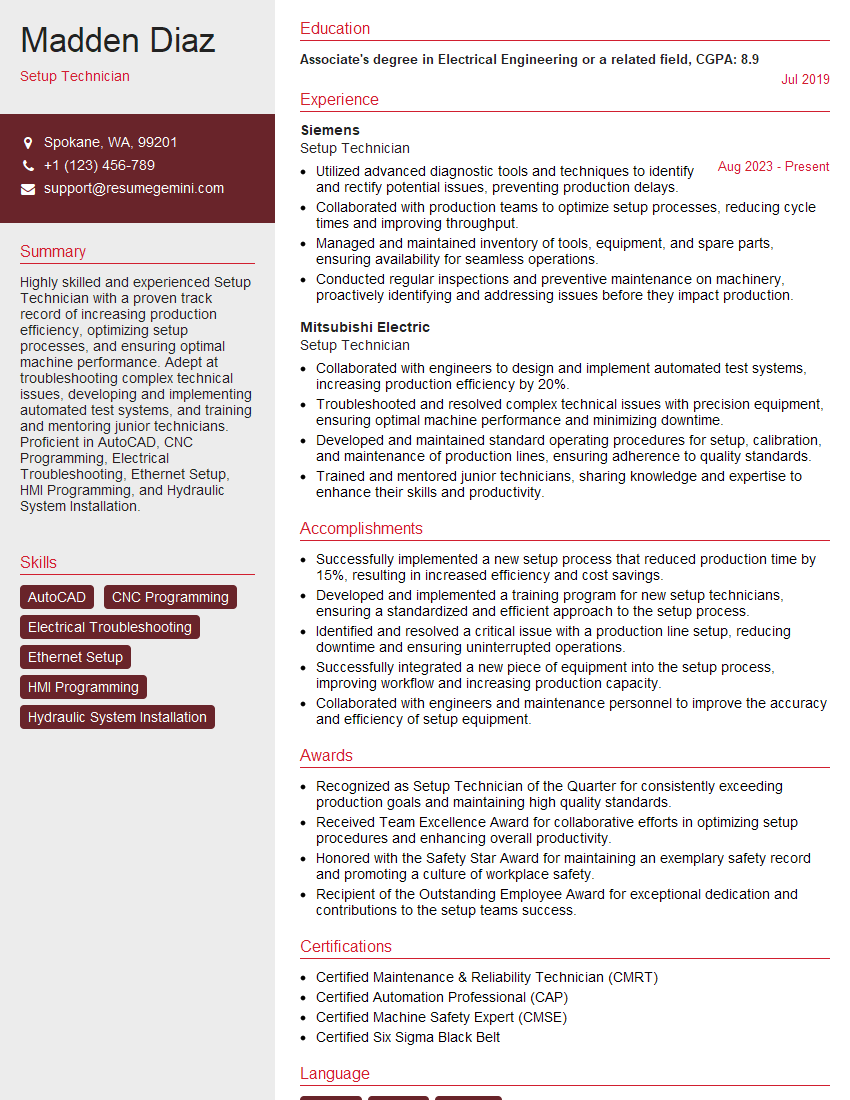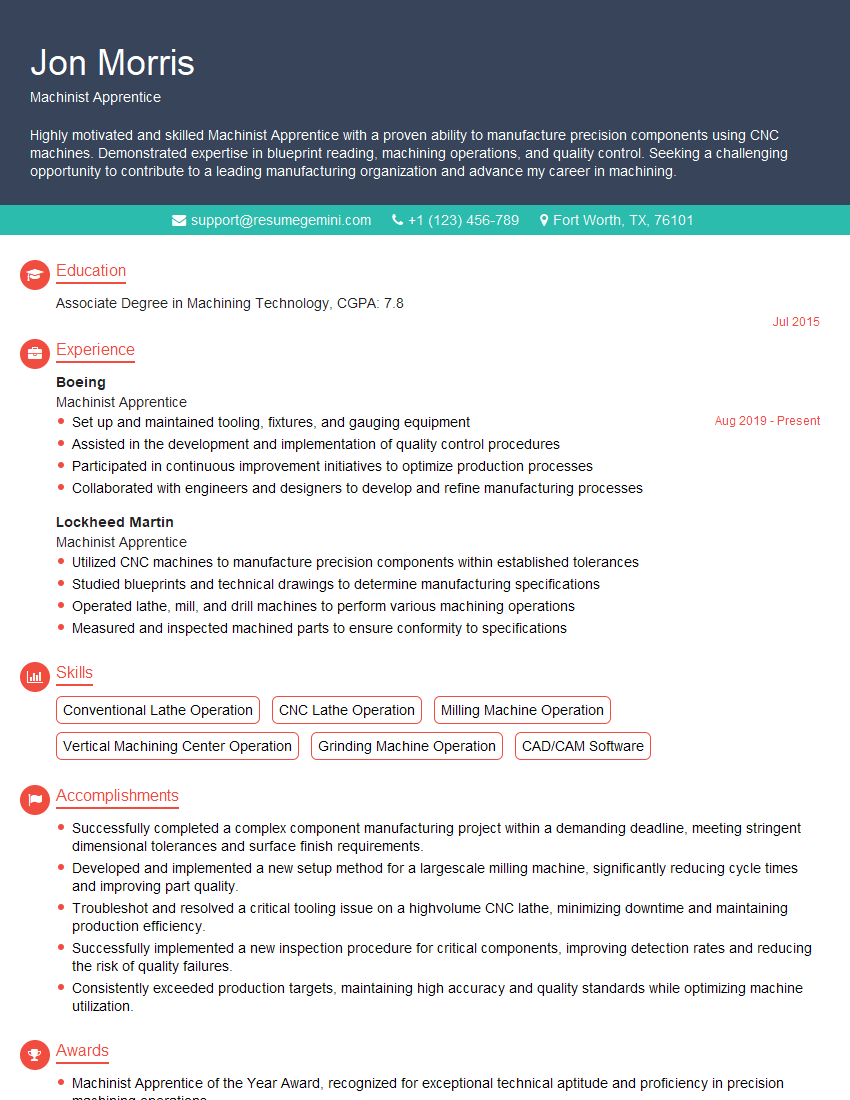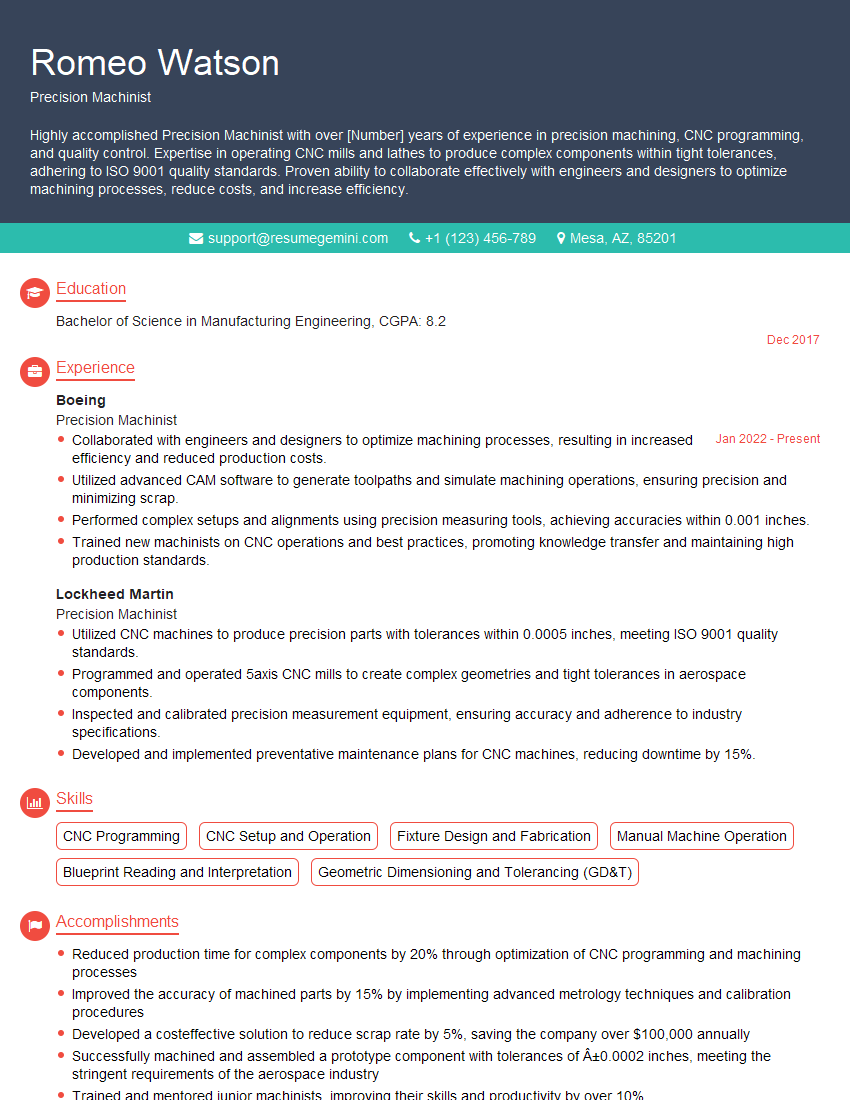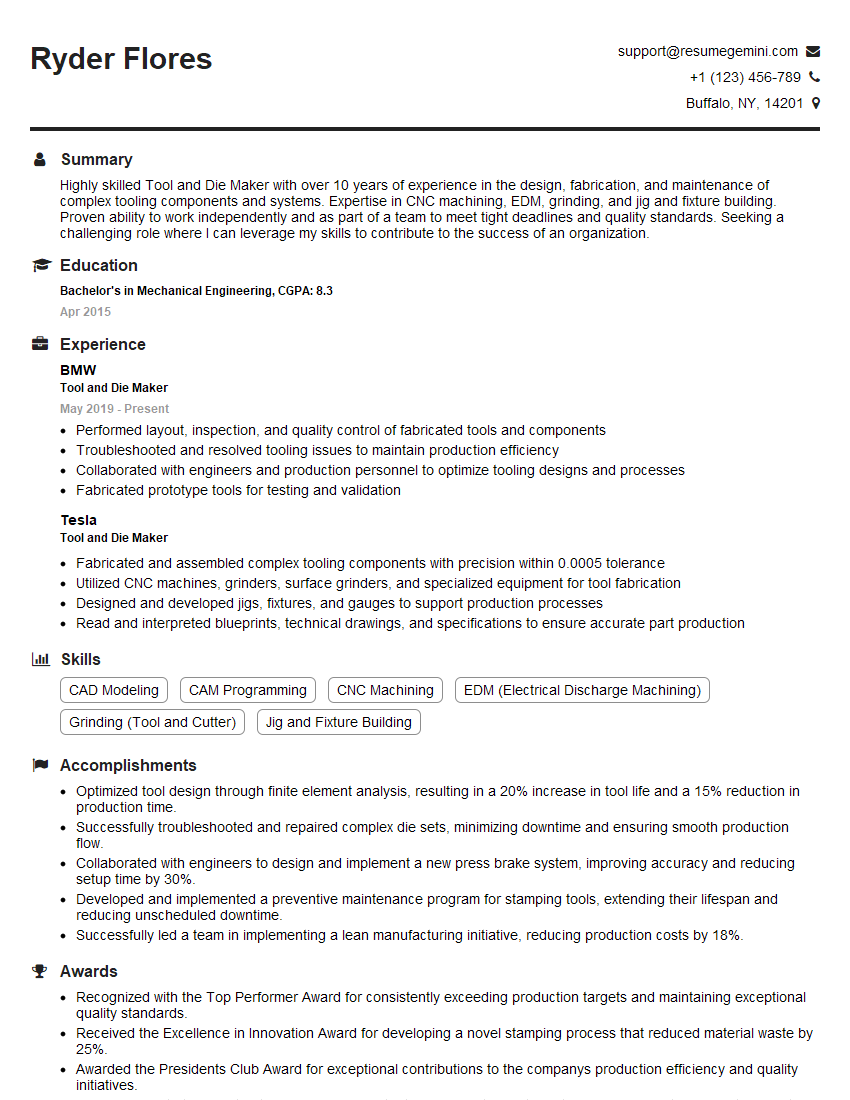Preparation is the key to success in any interview. In this post, we’ll explore crucial Machine Use interview questions and equip you with strategies to craft impactful answers. Whether you’re a beginner or a pro, these tips will elevate your preparation.
Questions Asked in Machine Use Interview
Q 1. Describe your experience with different types of machine tools.
My experience encompasses a wide range of machine tools, from traditional lathes and milling machines to sophisticated CNC (Computer Numerical Control) machining centers and EDM (Electrical Discharge Machining) systems. I’ve worked extensively with both manual and automated equipment. For example, I spent several years operating and maintaining a Bridgeport milling machine, honing my skills in precision milling operations. More recently, I’ve been focused on programming and operating five-axis CNC machining centers, where the ability to manipulate tools in multiple planes significantly expands design possibilities. This experience also includes working with grinders, both surface and cylindrical, crucial for achieving fine surface finishes and precise dimensions. I’m also familiar with specialized machines like wire EDM, used for intricate cutting of hard materials.
- Lathes: Used for rotating workpieces to create cylindrical shapes.
- Milling Machines: Used for removing material from a workpiece using rotating cutters.
- CNC Machining Centers: Computer-controlled machines offering high precision and automation.
- EDM Machines: Used for machining hard-to-machine materials using electrical discharges.
- Grinders: Used for achieving precise surface finishes and dimensions.
Q 2. Explain the process of setting up a CNC machine.
Setting up a CNC machine involves several crucial steps, all requiring precision and attention to detail. First, you need to import the CAD (Computer-Aided Design) file into the CNC machine’s control software. This software translates the design into a set of instructions the machine understands, specifying tool paths, speeds, and feeds. Then, you need to select the appropriate cutting tools based on the material and the desired surface finish. This often involves referring to tool libraries and selecting tools optimized for specific operations. Next, the workpiece is securely clamped to the machine’s table. This is critical to ensure accuracy and safety, as any movement during operation could lead to errors or damage. After verifying the tool setup and workpiece clamping, a trial run or simulation is often performed to check for collisions or other potential problems. Once everything is verified, the machining program can be initiated. Throughout the process, regular monitoring is crucial to identify and address any potential issues.
Imagine it like baking a cake. The CAD file is your recipe, the software is your instruction manual, the tools are your baking tools, and the workpiece is your cake batter. Each step must be followed carefully to achieve a perfect outcome.
Q 3. How do you troubleshoot common machine malfunctions?
Troubleshooting machine malfunctions requires a systematic approach. I usually start by identifying the symptom – is the machine making unusual noises, producing inaccurate parts, or completely malfunctioning? This leads to checking the most probable causes. For example, unusual noises might indicate a worn bearing or loose component, while inaccurate parts might suggest problems with tool wear, improper setup, or program errors. I always consult the machine’s manual for diagnostic codes or common troubleshooting steps. This includes checking for loose connections, ensuring proper lubrication, inspecting cutting tools for wear and tear, verifying the accuracy of the machine’s axes, and potentially checking the coolant system. Sometimes, you need to use specialized diagnostic tools, like digital calipers for accurate measurement, to pinpoint the problem. In complex situations, I would use a systematic approach, eliminating possible causes one by one until the root cause is found.
A recent example involved a CNC milling machine producing parts with slightly off-center holes. After careful inspection, I found that the tool holder had slightly shifted due to wear and tear on the clamping mechanism. This was a simple fix, but it highlighted the importance of regular inspection and maintenance.
Q 4. What safety procedures do you follow when operating machinery?
Safety is paramount when operating machinery. I always start by ensuring I’m wearing appropriate personal protective equipment (PPE), including safety glasses, hearing protection, and machine-specific safety gear such as gloves or a face shield. I never operate machinery without ensuring proper machine guards are in place and functioning correctly. Before starting any machine, I inspect the area around the machine to ensure that there are no obstructions that might cause injury. I always use proper lockout/tagout procedures when performing maintenance or repairs to prevent accidental activation. I also maintain a clean and organized workspace, preventing trips and falls. Regular training updates keep my knowledge of safety protocols current and relevant. Finally, I consistently follow all company safety procedures and report any unsafe conditions immediately.
Think of it as a racecar driver always wearing a seatbelt – it’s not optional, it’s essential for safety.
Q 5. What is your experience with preventative maintenance?
Preventative maintenance is crucial for maximizing machine uptime and minimizing the risk of costly breakdowns. My experience includes performing regular lubrication, cleaning, and inspection of machine components according to established maintenance schedules. I’m familiar with conducting visual inspections for signs of wear and tear, such as loose screws, damaged belts, or excessive vibration. I also perform regular checks of the coolant system, ensuring proper fluid levels and cleanliness to prevent corrosion or other problems. Furthermore, I meticulously record all maintenance activities and inspections to maintain a complete history for future reference. The goal is to catch potential problems early, before they escalate into major failures. Preventative maintenance can often be seen as an investment, as it saves time and money in the long run by preventing unexpected downtime and expensive repairs.
Regular maintenance is similar to regular checkups at a doctor’s office – catching small problems early prevents more serious issues down the line.
Q 6. Describe your experience with different types of cutting tools.
My experience encompasses a wide variety of cutting tools, each suited to different materials and machining operations. I’m familiar with high-speed steel (HSS) tools, carbide inserts, and ceramic tools, each offering different levels of hardness, wear resistance, and cutting performance. The selection of the right cutting tool is critical to achieving the desired surface finish and minimizing tool wear. HSS tools are generally suitable for less demanding applications on softer materials, while carbide inserts offer superior wear resistance and are often used for high-speed machining of harder materials. Ceramic tools provide even greater wear resistance but are more brittle. Beyond the material, the geometry of the cutting tool – including its rake angle, clearance angle, and cutting edge – also significantly affects its performance. I’m also familiar with different types of tooling, such as drills, reamers, end mills, and boring bars, each designed for specific machining processes. Understanding the capabilities and limitations of each tool is fundamental to efficient and effective machining operations.
- HSS (High-Speed Steel): General-purpose tools suitable for softer materials.
- Carbide Inserts: Offer superior wear resistance for harder materials.
- Ceramic Inserts: Excellent wear resistance, but more brittle.
Q 7. How do you interpret engineering drawings and blueprints?
Interpreting engineering drawings and blueprints is a fundamental skill for any machinist. I’m proficient in reading and understanding various types of drawings, including orthographic projections, isometric views, and sectional views. These drawings provide crucial information about the dimensions, tolerances, and surface finishes required for a part. I’m able to identify different views, understand dimensioning techniques, and interpret symbols and annotations related to surface finish, material specifications, and manufacturing processes. For example, I can accurately measure critical dimensions from drawings, such as diameters, lengths, and angles, using appropriate measuring tools. I can identify tolerances specified on drawings, such as plus/minus tolerances, indicating the allowable variations in dimensions. Understanding these drawings ensures I can accurately machine parts to the specifications provided. A common example is understanding the tolerance of a hole, ensuring it is within the specified limits to prevent malfunctions in the final assembly.
Imagine it as reading a map; it guides you step-by-step to create a precise and functional component.
Q 8. What is your experience with using measuring instruments (e.g., calipers, micrometers)?
My experience with measuring instruments like calipers and micrometers is extensive. I’ve used them daily for over 10 years, ensuring accurate measurements of machined parts. Calipers are excellent for measuring external and internal dimensions, while micrometers provide even higher precision for smaller measurements. For instance, I frequently use vernier calipers to check the diameter of a turned shaft, verifying it meets the specified tolerance. Micrometers are crucial when dealing with tight tolerances, like the thickness of a precision shim. I’m comfortable with both digital and analog versions and understand the importance of proper calibration and handling to avoid measurement errors. I understand the principles of zero setting and parallax errors and take steps to mitigate them.
Beyond calipers and micrometers, I also have experience with other precision instruments like dial indicators for checking surface flatness and runout, and height gauges for precise dimensional measurements.
Q 9. Explain your understanding of GD&T (Geometric Dimensioning and Tolerancing).
Geometric Dimensioning and Tolerancing (GD&T) is a language of symbols and standards used to clearly communicate the precise dimensions and tolerances of parts on engineering drawings. It goes beyond simple plus/minus tolerances by defining the permissible variation in geometry – including form, orientation, location, and runout – which is crucial for part functionality and assembly. For example, a simple tolerance might specify a shaft diameter as 10 ± 0.1mm. However, GD&T might add a cylindricity tolerance to control the roundness of the shaft, ensuring it fits properly in a mating hole even if the diameter is within the tolerance range.
Understanding GD&T is essential for producing parts that meet assembly requirements. I’m proficient in interpreting GD&T symbols and applying them during machining. I understand concepts like position tolerances (defining the location of a feature), perpendicularity (defining the angular relationship between features), and flatness (defining the evenness of a surface). Misinterpreting GD&T can lead to parts that fail to assemble correctly or have compromised functionality; my experience ensures I can avoid these issues.
Q 10. How do you ensure the accuracy and precision of machined parts?
Ensuring the accuracy and precision of machined parts requires a multi-faceted approach. It begins with meticulous planning and programming, using precise CAD/CAM software to generate toolpaths. Choosing the correct tooling is also critical; dull or incorrectly sized tools will result in inaccurate parts. During machining, maintaining consistent speeds and feeds according to the material being machined is crucial. Regular inspection using appropriate measuring instruments is also vital. I consistently perform in-process checks to catch errors early. Moreover, machine maintenance is paramount; regularly checking and calibrating machines is a key strategy for ensuring consistent and accurate outputs. Finally, controlling environmental factors like temperature can significantly influence precision, particularly in high-precision operations.
In practice, this means using statistical process control techniques to monitor variation in the process. If significant variation arises, I’ll investigate the root cause, whether it is a machine issue, tool wear, or an error in the program.
Q 11. Describe your experience with different types of machining processes (e.g., milling, turning, drilling).
My machining experience encompasses a wide range of processes, including milling, turning, and drilling. Turning, using lathes, is my forte; I’ve worked extensively on producing cylindrical parts with various geometries, from simple shafts to complex components with threads and shoulders. Milling, utilizing milling machines, is another core skill; I am proficient in various milling techniques such as face milling, end milling, and profile milling. I’ve created intricate shapes and features in various materials, often using CNC milling machines for complex parts. Drilling involves producing holes of varying sizes and depths; I’m adept at selecting appropriate drills and speeds for diverse materials to ensure clean, accurate holes. I understand the importance of selecting the right cutting parameters for each material and process to prevent tool breakage and ensure the final part’s quality.
For example, recently I used turning to produce a batch of precisely sized shafts with a specific surface finish. The project required exceptional precision and consistency, and I employed several techniques to ensure a successful outcome. My experience across these methods enables me to select the optimal process for any specific project requirements.
Q 12. How do you maintain the cleanliness and organization of your work area?
Maintaining a clean and organized workspace is paramount for safety and efficiency. My workspace is always kept meticulously clean, with tools and materials stored in designated locations. This prevents accidents from tripping hazards or misplacing tools. A clean environment also minimizes the risk of contaminating parts with debris or chips. I believe in the ‘5S’ methodology – Seiri (Sort), Seiton (Set in Order), Seisō (Shine), Seiketsu (Standardize), and Shitsuke (Sustain) – to maintain a consistently organized and productive workspace. This involves regular cleaning, proper tool storage, and implementing a system to prevent clutter. This discipline enhances efficiency by reducing search time for tools and materials. Furthermore, it creates a safer work environment and minimizes errors that could arise from a disorganized setting.
Q 13. Explain your experience with programming CNC machines.
My CNC programming experience is extensive, spanning several years and various control systems. I’m proficient in both G-code programming and using CAM software to generate CNC programs. I’m comfortable working with a range of CNC machines including mills and lathes. My experience encompasses the entire process, from part design in CAD to generating optimized toolpaths in CAM software and transferring them to the CNC machine. I’m well-versed in setting up and operating CNC machines, including tool changes, work holding, and machine calibration. I also have experience with troubleshooting and diagnosing issues that arise during CNC machining.
For instance, I recently programmed a complex part requiring multiple operations on a 5-axis CNC mill. The programming involved carefully considering tool selection, feed rates, and toolpath optimization to ensure efficient machining and high-quality surface finish. I’m adept at simulating programs before execution to identify and correct potential collisions or errors.
Q 14. What software are you proficient in (e.g., CAD/CAM software)?
My software proficiency includes various CAD/CAM packages. I have extensive experience with SolidWorks for 3D modeling and design, creating detailed models for parts and assemblies. I use Mastercam extensively for generating CNC toolpaths. I’m also familiar with other CAM software packages such as Fusion 360 and understand the nuances of different post-processors. My skills extend to using measurement and inspection software for verifying part dimensions and geometry. Moreover, I’m familiar with spreadsheet software for data analysis and process documentation. I’m a quick learner and adapt easily to new software packages as required by a project.
Q 15. How do you handle unexpected machine downtime?
Unexpected machine downtime is a serious issue that can disrupt production and impact deadlines. My approach involves a systematic troubleshooting process. First, I identify the cause of the downtime – is it a power failure, a mechanical malfunction, a software glitch, or something else? This often involves checking error logs, reviewing machine sensors, and visually inspecting the equipment.
Once the cause is identified, I follow established protocols. For example, a minor software error might be resolved by restarting the machine or applying a software patch. More significant mechanical issues might require calling in a specialist or replacing a faulty component. I meticulously document each step of the troubleshooting and repair process, including the time of the downtime, the cause, the steps taken to resolve the issue, and the outcome. This ensures that we can analyze trends, prevent future downtime, and improve our overall maintenance strategies.
In a previous role, we experienced a recurring problem with a CNC milling machine. After carefully logging the downtime events, we discovered a pattern linked to high ambient temperature. By installing a better cooling system, we significantly reduced downtime caused by this issue.
Career Expert Tips:
- Ace those interviews! Prepare effectively by reviewing the Top 50 Most Common Interview Questions on ResumeGemini.
- Navigate your job search with confidence! Explore a wide range of Career Tips on ResumeGemini. Learn about common challenges and recommendations to overcome them.
- Craft the perfect resume! Master the Art of Resume Writing with ResumeGemini’s guide. Showcase your unique qualifications and achievements effectively.
- Don’t miss out on holiday savings! Build your dream resume with ResumeGemini’s ATS optimized templates.
Q 16. Describe your experience with quality control procedures.
Quality control is paramount in machine operation. My experience encompasses a range of procedures, from visual inspection of parts for defects to the use of sophisticated measurement tools like CMMs (Coordinate Measuring Machines) and optical comparators. I’m proficient in interpreting blueprints and technical drawings, ensuring the machined parts adhere to specified tolerances and surface finishes. We employ statistical process control (SPC) methods to monitor key process parameters, identify trends, and prevent defects before they occur. This involves regularly collecting data, plotting control charts, and analyzing the results to detect shifts in the process that might lead to quality problems.
For example, in one project involving the production of precision gears, we used SPC charts to monitor gear tooth thickness and concentricity. By monitoring these parameters, we were able to identify a slight shift in the cutting tool’s alignment, preventing a batch of substandard gears from being produced. We then adjusted the tool and resumed production with improved quality.
Q 17. How do you identify and resolve quality issues in machined parts?
Identifying and resolving quality issues requires a combination of careful observation and systematic analysis. I begin by visually inspecting the parts for obvious defects like scratches, burrs, or dimensional inaccuracies. I then use precision measuring instruments to verify dimensions and tolerances against the specifications. If deviations are found, I analyze the process parameters – things like spindle speed, feed rate, cutting tool wear, and workpiece clamping – to identify the root cause. This might involve reviewing machine logs, inspecting the tooling, and checking the accuracy of the CNC program.
For instance, if parts are consistently coming out undersized, it could indicate a problem with the machine’s tool length offset, the cutting tool itself, or even a programming error. Through systematic investigation, we can pinpoint the problem and correct it. This often involves calibrating the machine, changing worn tooling, or modifying the CNC program. Thorough documentation ensures that the issue is resolved and doesn’t reappear.
Q 18. Explain your understanding of machine safety regulations.
Machine safety regulations are of utmost importance. I’m familiar with OSHA (Occupational Safety and Health Administration) guidelines and other relevant regulations applicable to machine operation. This includes understanding and adhering to lockout/tagout procedures (ensuring machines are properly shut down and locked out before maintenance or repair), using appropriate personal protective equipment (PPE) such as safety glasses, hearing protection, and gloves, and maintaining a clean and organized work area to prevent accidents.
Regular machine inspections are also critical for safety. I check for potential hazards such as frayed cables, loose parts, or signs of wear and tear. I also understand the importance of emergency stop mechanisms and ensuring they are readily accessible and functioning correctly. Safety isn’t just a checklist; it’s a mindset that prioritizes preventing injuries and protecting everyone in the workplace.
Q 19. Describe your experience with working in a team environment.
I thrive in team environments. Effective teamwork is essential for efficient production and high-quality results. In my experience, successful collaboration involves clear communication, mutual respect, and a shared commitment to achieving common goals. I actively contribute to team discussions, sharing my expertise, and listening to the perspectives of my colleagues. I also understand the importance of delegating tasks effectively and supporting team members when they need assistance.
In one project, our team faced a challenging deadline to manufacture a complex assembly. By collaborating effectively – each member focusing on their area of expertise while supporting one another – we not only met the deadline but also exceeded quality expectations. Open communication and trust were key to our success.
Q 20. How do you prioritize tasks when working on multiple machines?
Prioritizing tasks when working on multiple machines requires a structured approach. I typically use a combination of methods, including urgency and importance. I start by assessing the due dates and the criticality of each task. Tasks with imminent deadlines or those impacting subsequent operations usually take priority. I also consider the setup time and the complexity of each task. For example, a complex setup that requires several hours might be scheduled ahead of simpler tasks to maximize machine utilization.
I often use a Kanban-style board or a similar system to visually track progress and prioritize tasks. This helps me stay organized and maintain a clear overview of all ongoing work. Adaptability is key; unforeseen issues may require adjustments to the task schedule.
Q 21. How do you document your work and maintain records?
Meticulous documentation is crucial for maintaining accurate records and ensuring traceability. I document every aspect of my work, from machine settings and tool specifications to the materials used and the quality inspection results. I utilize both electronic and paper-based systems, depending on the specific requirements. This might involve using a Computerized Maintenance Management System (CMMS) for machine maintenance logs, spreadsheets for tracking production data, or detailed reports for quality control findings.
Clear and consistent documentation ensures that others can understand my work, and it’s crucial for identifying trends, troubleshooting problems, and ensuring compliance with regulations. For example, keeping a detailed record of tool changes and their performance helps predict when a tool needs replacement, preventing potential quality issues.
Q 22. What is your experience with different materials (e.g., metals, plastics)?
My experience with various materials is extensive, encompassing a wide range of metals, plastics, and composites. With metals, I’ve worked extensively with aluminum alloys (like 6061 and 7075), stainless steels (various grades), mild steel, and titanium. My understanding extends to their machinability – how easily they can be cut, shaped, and formed – considering factors like hardness, ductility, and tendency to work-harden. With plastics, I’m familiar with thermoplastics such as ABS, polycarbonate, and polyethylene, and thermosets like epoxy and polyester resins. I understand the importance of selecting appropriate cutting tools and speeds for each material to prevent damage to the tool or the workpiece and achieve the desired surface finish. For composites, I’ve worked with carbon fiber reinforced polymers (CFRP), understanding their unique properties and the need for specialized tooling and techniques. My experience includes not only selecting the correct materials for a job but also diagnosing issues caused by material incompatibility or degradation.
Q 23. How do you select the appropriate cutting tools and parameters for a given material?
Selecting the right cutting tools and parameters is crucial for efficient and safe machining. It begins with understanding the material’s properties. For example, a hard material like hardened steel requires a much stronger and sharper tool, like a carbide insert, and a slower cutting speed compared to a softer material like aluminum, which can be machined with a high-speed steel tool at a higher speed. The cutting speed (measured in surface feet per minute or SFM), feed rate (how quickly the tool advances into the material), and depth of cut significantly impact the machining process. I use various resources including material datasheets, tool manufacturer catalogs, and experience to determine these parameters. For instance, if I’m working with stainless steel, I’d select a carbide insert designed for stainless steel, considering the tool geometry (e.g., rake angle, relief angle) to optimize the cutting process. I’ll then use established formulas or software to calculate optimal SFM and feed rate, always staying within the safe operating limits of the machine and the tool. Incorrect parameters can lead to tool breakage, poor surface finish, or even damage to the machine.
Q 24. Explain your understanding of different types of machine lubricants and coolants.
Machine lubricants and coolants play vital roles in extending tool life, improving surface finish, and preventing overheating. There are various types, each suited for different applications. Cutting fluids can be broadly categorized into:
- Water-miscible fluids: These are blends of water and oil or other additives, providing good cooling and lubrication. They’re commonly used for many machining operations. Different formulations offer varying levels of lubricity and corrosion protection.
- Straight oils: These are typically mineral-based oils and offer excellent lubrication but limited cooling capacity. They’re suitable for operations where lubrication is paramount, such as heavy-duty turning or drilling.
- Synthetic fluids: These are engineered fluids offering enhanced performance, often with improved cooling, lubrication, and environmental characteristics. They’re often preferred where high precision and long tool life are crucial.
- Dry machining: In some cases, particularly with advanced materials, dry machining (without any coolant) is employed to avoid coolant-related issues like corrosion or contamination. This often requires specialized tooling and precise control of cutting parameters.
Selecting the appropriate coolant depends on factors like the material being machined, the machining operation, and the machine’s capabilities. Incorrect coolant choice can lead to poor surface finish, reduced tool life, or even machine damage.
Q 25. How do you ensure the efficient use of machine resources?
Efficient use of machine resources involves several strategies focused on minimizing waste and maximizing productivity. This includes optimizing cutting parameters to reduce machining time and material waste, as discussed earlier. It also involves careful planning of machining sequences to minimize setup time and material handling. Preventive maintenance plays a crucial role; regularly scheduled maintenance prevents unexpected downtime and ensures the machine operates at peak efficiency. Moreover, efficient tooling management – including proper storage, organization, and selection – contributes significantly. Tracking tool life and usage patterns helps optimize tooling selection and purchasing. Finally, monitoring energy consumption and implementing energy-saving practices (such as using variable-speed drives) contributes to efficient resource utilization.
Q 26. Describe a time you had to troubleshoot a complex machine problem.
During a high-volume production run of a complex aerospace component, we experienced inconsistent surface finish on a critical feature. The initial troubleshooting involved checking the cutting tools, machine settings, and coolant. After ruling out those factors, I investigated the machine’s vibration patterns using sensors and data acquisition equipment. The analysis revealed a resonant frequency issue at a specific spindle speed, causing undesirable vibrations that led to the inconsistent finish. The solution involved adjusting the spindle speed to avoid the resonant frequency range, achieving a consistent surface finish. This incident highlighted the importance of systematic troubleshooting, involving data-driven analysis rather than relying solely on intuition. The ability to use diagnostic equipment and interpret data was critical to solving the problem effectively.
Q 27. What steps do you take to ensure the safety of yourself and your coworkers?
Safety is paramount in my work. I meticulously follow all safety protocols, including wearing appropriate personal protective equipment (PPE) such as safety glasses, hearing protection, and appropriate clothing. Before operating any machine, I perform a thorough pre-operational inspection, checking for any loose parts, leaks, or other potential hazards. I ensure that all safety guards are in place and functioning correctly. I also maintain a clean and organized work area to minimize tripping hazards. Furthermore, I regularly communicate with coworkers, alerting them to potential hazards and working together to ensure a safe environment. I’m familiar with lockout/tagout procedures and follow them strictly when performing maintenance or repairs. Proactive identification of potential hazards and a commitment to safe practices are integral to my work ethic.
Q 28. How do you stay up-to-date with new technologies and advancements in machine use?
Staying current with advancements in machine use requires a multi-pronged approach. I regularly attend industry conferences and workshops to learn about new technologies and best practices. I subscribe to industry-specific publications and journals, keeping up-to-date with research and developments. Online resources, such as professional organizations’ websites and technical forums, provide valuable insights. I also participate in professional development courses focusing on advanced machining techniques, new materials, and software updates related to CNC programming and machine control. Furthermore, I actively seek out opportunities to work with newer machines and technologies to gain hands-on experience, ensuring my skillset remains relevant and at the forefront of the industry.
Key Topics to Learn for Machine Use Interview
- Machine Operation & Safety Procedures: Understanding the specific machine’s functionalities, safety protocols, and emergency procedures. This includes pre-operational checks and routine maintenance.
- Troubleshooting & Diagnostics: Identifying and resolving common machine malfunctions, using diagnostic tools and techniques to pinpoint issues efficiently. Practical experience in troubleshooting is crucial.
- Quality Control & Assurance: Understanding quality control metrics and procedures relevant to the machine’s output. Knowing how to identify defects and ensure consistent product quality.
- Maintenance & Repair: Basic understanding of preventative maintenance schedules, common repair procedures, and the ability to identify parts needing replacement.
- Production Optimization: Knowledge of techniques to maximize machine efficiency, minimize downtime, and improve overall production output. This often involves understanding process flow and material handling.
- Data Analysis & Reporting: Analyzing machine performance data to identify trends, areas for improvement, and to generate reports for management. Proficiency with relevant software is beneficial.
- Regulatory Compliance: Familiarity with relevant safety regulations and industry standards pertaining to machine operation and maintenance.
Next Steps
Mastering machine use is vital for career advancement in many manufacturing and industrial sectors, opening doors to specialized roles and increased earning potential. To stand out, create a compelling resume optimized for Applicant Tracking Systems (ATS). This ensures your application gets noticed by recruiters. ResumeGemini is a trusted resource to help you build a professional and effective resume tailored to highlight your machine use skills and experience. Examples of resumes specifically tailored for Machine Use positions are available to help guide you.
Explore more articles
Users Rating of Our Blogs
Share Your Experience
We value your feedback! Please rate our content and share your thoughts (optional).
What Readers Say About Our Blog
Hi, I represent an SEO company that specialises in getting you AI citations and higher rankings on Google. I’d like to offer you a 100% free SEO audit for your website. Would you be interested?
Hi, I represent an SEO company that specialises in getting you AI citations and higher rankings on Google. I’d like to offer you a 100% free SEO audit for your website. Would you be interested?
Dear Sir/Madam,
Do you want to become a vendor/supplier/service provider of Delta Air Lines, Inc.? We are looking for a reliable, innovative and fair partner for 2025/2026 series tender projects, tasks and contracts. Kindly indicate your interest by requesting a pre-qualification questionnaire. With this information, we will analyze whether you meet the minimum requirements to collaborate with us.
Best regards,
Carey Richardson
V.P. – Corporate Audit and Enterprise Risk Management
Delta Air Lines Inc
Group Procurement & Contracts Center
1030 Delta Boulevard,
Atlanta, GA 30354-1989
United States
+1(470) 982-2456





